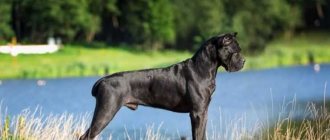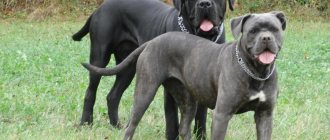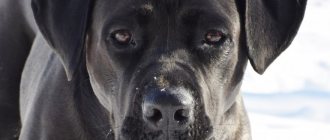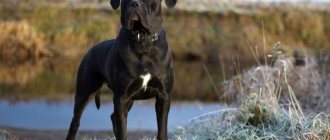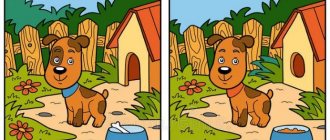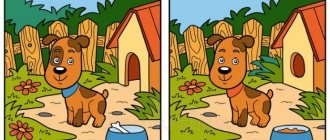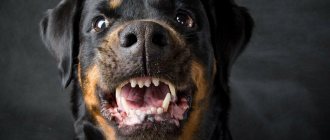The menacing appearance of the Cane Corso inspires fear and respect. This dog is compared to a powerful weapon that can deter any aggression. The military victories of the Cane Corso are glorified in the novels of Italian writers Erasmus di Valvasone and Giovanni Verga.
War dogs are depicted in engravings by Bartolo Pinelli and paintings by artist Philipp Hackert. Modern Cane Corsos have a more docile character than their distant ancestors. With proper upbringing, the dog will become a true family friend and an excellent companion.
History of the breed
The first mention of the Cane Corso dog appeared in the 15th century AD. e. The animal is a distant ancestor of the Old Roman Dane and belongs to the Molosser group. In ancient times, dogs herded sheep, looked after horses and participated in military campaigns along with Roman legionnaires.
Cane Corso, living in southern Italy, helped hunters hunt bears and other large predators. Dogs fought in the Colosseum arena against gladiators, lions, tigers and buffaloes. The breed gained particular popularity during the Renaissance.
The growth of cities and industrialization led to the fact that the abilities of the Cane Corso were unclaimed. The number of Italian dogs decreased especially dramatically during the First and Second World Wars. At some point, the breed was on the verge of extinction. Only thanks to the efforts of a group of Italian dog handlers (Paolo Breber, Stefano Gandolfi, etc.) was it possible to preserve the number of animals. The International Canine Association recognized the Cane Corso in 1996.
Description of the appearance of the Cane Corso breed
The first breed standard was drawn up back in 1984, before its recognition. Approved by the International Canine Organization in 1996. According to the standard, Cane Corso dogs must be above average height, strong, and powerful. But thanks to their proportional build, they weigh little, males weigh up to 50 kg, females – up to 45 kg. The height at the withers is 60-68 cm.
Head
The head is mastiff-shaped, large, wide, without folds. The muzzle is slightly upturned, shorter than the skull, almost square in shape. The forehead is convex, the transition from it to the muzzle is pronounced. The bridge of the nose is straight, the lobe is large and black. The upper lips hang down, covering the lower jaw. The Cane Corso has 42 large, curved teeth. The jaws are strong and easily chew through bones and thick sticks. A slight undershot is characteristic - the lower jaw protrudes forward.
The eyes are oval, medium in size, slightly convex, and should be dark. Set straight, widely spaced, eyelids close. The look is direct, intelligent, attentive. The ears are triangular, set high, and medium in size. Usually hanging, close to the muzzle, but sometimes they are docked in the shape of a triangle.
Torso
The physique is powerful, proportional, with prominent muscles. The body is slightly stretched, the length is greater than the height, it is 80-85 cm. The Cane Corso moves with grace, easily and freely. The movements are flexible, like those of a cheetah.
The neck is muscular and quite long. The chest is wide, the shoulders protrude. The withers rise slightly. The back is level, the loin is short, the croup is wide and sloping. The tail is set high and thick. According to the standard, it is stopped at the level of the 4th vertebra. The dog keeps the tail raised, but not vertically, it should not bend.
Limbs
The limbs are muscular and quite long. The front ones are set parallel, the shoulders are vertical. The thighs are long, the legs are strong. The paws are soft, wide, cat-type. Thanks to this, the dog’s movements are light, free, and runs at a sweeping trot.
The photographs allow you to understand what this dog should look like:
Photos of Cane Corso dogs
Wool
The skin is thick and fits tightly. The coat is thick, hard, shiny and smooth, up to 1 cm long. The undercoat is pronounced and protects the dog from extreme conditions. Lack of undercoat is considered a disqualifying fault, as is wavy, dull coat.
The Cane Corso has several colors allowed:
- black is the most common, classic color;
- gray or dark gray;
- brindle;
- brown.
Dogs of any color are allowed white markings on the chest, tips of the paws, and the back of the nose. Brindles and browns should have a black mask on their face. White dogs are not allowed for breeding.
This breed has different colors, which can be seen in the photo:
Cane Corso brindle color
Red Cane Corso
Gray color
Deviations from the standard
This breed began to be bred recently, with a small number of individuals. Therefore, there are still many varieties that do not meet the standard:
- Mastino is characterized by a large number of folds on the skin, drooping eyelids, and a heavy build;
- mastiffs - with long legs, a small head, a narrower muzzle;
- bullmastiff - round muzzle, many folds, drooping jowls, close-set eyes;
- boxer - shorter, squat, square body, snub-nosed muzzle, round eyes;
- Staffordshire Terrier – wedge-shaped muzzle, aggressive disposition.
Cane Corso character
Representatives of the breed have a high level of intelligence, developed intuition and intelligence. The animal's nervous system is highly resilient. The dog is devoted to its owner and his family members. She is calm with cats and other pets.
Cane Corsos are good with children .
They play with the kids with pleasure and forgive them all pranks and pranks. The dog has innate protective and territorial instincts and is distrustful of strangers. In battle he is brave and merciless. In critical situations, the dog can make independent decisions and act according to the situation.
Education and training
The dog requires early socialization. You need to take your puppy for frequent walks in crowded and noisy places. He must constantly communicate and play with other animals. The dog should also periodically interact with children and adults. The dog needs to understand who the “leader of the pack” is. The main figure for a puppy should always be its owner.
Cane Corso training should begin at six months of age.
You shouldn't indulge your dog in everything. Excessive callousness and cruelty are also not welcome. Dog handlers advise observing the following rules when communicating with Cane Corso:
- Don't let your dog into the kitchen and don't feed him food from the table.
- Do not let your animal sleep on the bed or other furniture; buy her a spacious bed.
- Occasionally stand with your foot on the dog's bed (only the owner has the right to violate someone else's territory).
- Don't let your Cane Corso bite your hands or feet while playing.
- Try not to step over the animal or avoid it. It should give way to you on its own.
Mastering the commands included in OKD should be reinforced with praise or treats. To stop unwanted behavior, you can use a stern, disapproving tone. If the animal does not respond to your commands, then cane corso training should be carried out together with a professional instructor.
The dog requires regular exercise. Cane Corsos especially love agility (passing obstacle courses) and running. Special exercises and training will make your dog a competent watchman or bodyguard. It will be able to protect your apartment, car and personal property from criminal attacks.
“DANGEROUS DOG” – PROBLEM AND JUDGMENTS.
Today, the media often talks about “dangerous dogs.” The reason for this is tragic cases in which a dog is somehow involved, a lot is said about the potential danger of dogs of certain breeds, about the need for a special “animal law”, while journalists and politicians refer to the experience of other countries where bans on certain dog breeds have been introduced. We see: an attempt to attract public attention to the problem of dogs dangerous to humans, and politicians doing their own PR on this problem. What's really going on? Why is this problem so acute lately, since humans are connected with dogs over thousands of years of history? Moreover, I note that it is precisely in our days, in the era of technical-urban civilization, that the character of many dog breeds has irreversibly changed towards softening; ferocious warrior dogs and hunters, without the work for which they were bred, have become harmless hulks and companions. Journalists have repeatedly approached me with questions regarding the dangers of dogs and the presence of dangerous breeds. Let's try to look at the problem from all sides, the way it looks from the point of view not of emotions, but of the realities of life.
About "fighting dogs". First of all, what is a “fighting dog”? There are fighting fish and fighting roosters, but there are no such dogs - this word was invented by people who themselves do not understand what they are talking about. There were fighting (military) dogs, as well as poisoning dogs, which were used for hunting, fights with animals for the amusement of the public (it was such a medieval pastime) and fights with their own kind. Now in the world there are more than 400 dog breeds recognized by international canine organizations. The largest of which is the FCI, which unites more than 100 countries, including Russia, which is represented in this union by our largest cynological organization - the Russian Cynological Federation (RKF). In the FCI system, baiting and fighting are prohibited; in this system there is no selection (selection) of dogs for fighting qualities. There are classifications of dog breeds based on origin and purpose, but modern classifications do not include fighting or baiting dogs. The “closest” to fighting dogs are service dogs, used as guard dogs, patrol dogs, escort dogs, etc., these dogs are in demand by armies, law enforcement agencies, government services of all countries without exception, and there is no talk of their “danger” or ban. one country, although it is in these breeds that selection takes place for such quality as aggressiveness towards humans. Today, with some stretch, it is possible to call dogs used for underground dog fighting “combat”, but this is not a breed, but rather a “profession”. Talented fighters occur in different breeds; dogs of large guard breeds (including domestic shepherd dogs) often took part in fights; currently dog fighting is prohibited in all civilized countries, including Russia. An important feature of dogs that participated in battles (and were bred for them) is that they can under no circumstances be malicious towards strangers. Because dogs are both allowed into the ring and taken away. In this case, both owners are “strangers” (each for one of the dogs). And the dog should not “switch” to the person (which sometimes happens with fighting dogs of “non-fighting” breeds - when it gets to the people who take them away). I’m not saying that these dogs are the sweetest and most harmless creatures, but due to their “natural” (more precisely, the properties inherent in the breed by people), anger towards people is uncharacteristic for them. It can be formed during the upbringing and training of such a dog (being strong, passionate and persistent, the dog will certainly become a terrible opponent), but what kind of “danger” of the breed can we talk about if we are talking about upbringing and training - processes carried out by HUMAN ? How can one talk about a breed, implying a rare “profession”, about the “fault” of a dog, if a person created it that way? How can one find the line of objectivity if, based on historical facts, the vast majority of dogs were fighters or warriors in the past - what to do, because the history of a dog is a reflection of our history? Is it right to mix everything up to such an extent? Isn’t that absurd? It seems that we are talking not so much about the inherent danger of dogs of a number of breeds, but about the irresponsibility and blatant disgrace that is done to dogs by some owners. And it is people who should be the object of legislative measures aimed at preventing tragedies. First of all, the culprits (dog owners). And the punishment must be serious (not a symbolic fine) and inevitable. And with the involvement of the same media (so that it is known, so that it enters the public consciousness). Then others will have something to think about.
On breed bans: foreign experience. We are given as an example the legislation of some countries where there are lists of “prohibited breeds”. In fact, I would not limit myself to legislative examples (and their implementation) only in relation to dogs, but I would also pay attention to how many crimes are committed in these countries, whether old people rummage through garbage dumps, how many people are deprived of parental rights there, how how deputies behave, what is the level of corruption and social protection of the population, and how things generally stand there. I looked at it comprehensively, so to speak. Before blindly copying individual laws you like without reference to the realities of life. But even if we return to dogs not in the abstract, but in reality, amazing things are revealed. First of all, the pioneers of prohibitions were England and some other countries of the Old World. And these prohibitions themselves apply ALWAYS and EVERYWHERE only to foreign dogs. No country has banned its own national breed (regardless of its character, history and purpose), the lists of breeds in different countries are different, often in the Old World American breeds appear on them. Moreover, all the prohibited “Americans” are direct descendants and closest relatives of European dogs (most often English ones), NEVER subject to a ban in their homeland. Is it possible that the character of dogs irreversibly changes depending on the geography of their residence with an accuracy of hundreds of kilometers? Legally, it is very difficult to objectively prove the breed of a particular dog. Everyone remembers how the phrase “a man who looks like the prosecutor general” became a catchphrase in our country. Likewise, a pit bull or other dog can easily become an “N-type dog.” I think there will be lawsuits with protests, and the production of certificates and documents, including in the CIS countries. As a result, there will still be many opportunities to circumvent the law. And a completely open question - what if this dog is a mixed breed? A mongrel with an unknown history and origin? Also, I note that not a single journalist or deputy in our country is able to formulate what he understands by the concept of “dangerous dogs”, that is, the breed, characteristics, some clear and specific outlines of the problem, what kind of creature this actually is. Or rather, everyone, of course, will say, but everyone is different, that is, people have a poor idea of the form of the phenomenon. There is no unity of views regarding their list; moreover, domestic breeds are considered as candidates for it - a national treasure and selection achievements of Russia.
Who are we afraid of? How dangerous are dogs? Today, the Pit Bull Terrier and American Staffordshire Terrier breeds appear most often on the lists of “dangerous dogs” (they are also the most often banned). These are the “leaders”. The Pit Bull Terrier is a breed not recognized by most canine organizations in the international FCI system (more than 100 countries), including the largest canine organization in Russia, the RKF. That is, de facto – the breed exists, but de jure (according to documents of origin) – it seems to not exist at all (how to ban them is no longer entirely clear, since it is impossible to ban something that apparently does not exist). Although, of course, such dogs also exist with the American Staffordshire Terrier - a popular and numerous breed - they are close relatives, descendants of English and European breeds, which separated in the 70s of the last century. What is characteristic is that their closest relative, practically 80% ancestor, the English Staffordshire Bull Terrier, is not prohibited in any country in the world. Although until 1976, dogs of this breed were bred in the USA in a single stud book with the Amstaff (now banned in England), that is, they were considered a single breed. I have already spoken about the practice of “double standard” in determining the danger of breeds, but let’s see how dangerous such a creature “domestic dog” is for humans. Let's look at the numbers: 76,410 dogs of the American Staffordshire Terrier breed are registered in the RKF stud book (I would like to note to gentlemen of the deputies that dogs are registered by adults, so this figure is not only dogs, but also potential voters), 5,620 puppies were registered in 2005. Now compare these figures with the number of tragedies (usually they do not pass by the media, you can remember) in which such dogs were the cause... Don’t you think, given the number of Amstaffs living nearby, that we are being called upon to “fight with kitchen knives” (kitchen knife - including a weapon for everyday murders, but for some reason it is not prohibited anywhere)? Anything to think about? In light of the numbers? Why do steel monsters continue to roam our streets, killing and maiming more than 200,000 people a year? Despite the army of traffic police officers and traffic rules. Why don’t journalists pay such close attention to every disaster that claims a human life? Or are other people dying, with a different value of life? And this does not bother either deputies or journalists? Or do they take it for granted and see no cause for concern? It's a strange world we live in...
Why can a dog be dangerous? If a dog bites an intruder, this is correct, if a neighbor, this is very bad, and if a minor neighbor, this is terrible, since the dog bit a child. But from the point of view of the dog’s instincts, it performs the same action - it bites a stranger, and only the dog’s owner is responsible for how, when and what it does, what harm or inconvenience it causes to others. Is it legal to ban an entire breed of dog on the basis of an action (even a terrible one) of a dog of one breed or another? What will happen if the owner who raised this dog and allowed this behavior gets another dog of a different breed? Will we ban ALL breeds, or will we still pay attention to the owner? How to do it RIGHT? The dog is a very receptive creature. By raising a puppy, a person becomes its “pack leader,” an example to follow and a leader in action. It is common for a dog to strive to “match the leader”, realizing sometimes clearly unexpressed aspirations. You can joke as much as you like about the similarities between dogs and owners, but there is a fact in this joke: in the process of raising a dog, a person projects the properties of his personality onto it. And those psychological and emotional strings that exist in the community of people resonate in the dogs living with them. In a society infected with fear, anger, feelings of failure and insecurity, dogs cannot be so much better than people that they do not succumb to the general atmosphere. Low level of safety in society: a huge number of potentially dangerous dogs are kept by people involuntarily, due to their low confidence in safety. People do not have any illusions about their protection by law enforcement agencies; society has not developed a culture of respect for other people’s property, for life itself. This is a huge social problem, which, in principle, cannot be solved by banning dog breeds or any instructions to their owner. The demand for dogs “for protection” is generated by social conditions in the state - for comparison, in the list of the ten most popular breeds in the RKF, two thirds are guard, service or sports (suitable for training in protective courses), and in neighboring Finland - their similar top ten is not NONE like this. How well some legislators “understand” the problem was very revealingly demonstrated by Yabloko deputy Sergei Mitrokhin: “the faction will strive to ensure that causing harm with the use of a dog is highlighted as a separate article.” The Criminal Code stipulates responsibility for one’s actions in the event of harm (regardless of the means - a knife, a dog or a stool).
Of course, you need to fight the cause. With anxiety, with anger, with low culture, with disrespect for the life and property of fellow citizens. And declarations alone cannot do this; even the best law involves solving problems that have nothing to do with dogs, and most importantly, it provides for an ENFORCEMENT MECHANISM. Because laws are good not when they are well written, but when they are followed by at least one living soul. Let's see how things are going with the implementation and are we really lacking them?
The need for animal law. The bills regarding dog breeding, discussed and presented in the media as a “necessity,” attempt to solve three global problems: on keeping domestic dogs and, separately, dangerous breeds, on cruelty to animals, and on stray and stray dogs. In fact, as was said, the problem does not lie in the plane of dog breeding, but has deep social roots. But even with regard to what is presented as some kind of “legal imperfection” of the current norms, deputies and the media are disingenuous. They are misleading us. First of all, because there is no “legal vacuum” in terms of keeping animals and animal protection. As already mentioned, a dog by itself cannot be a bearer of evil; it has no morals. The person, the owner, bears all responsibility for its upbringing, socialization and behavior. Which, in turn, must obey the legal norms of society. But you and I live in a country with a massively law-abiding population, in a society with a low level of respect for other people’s property and life. This is an effect of post-totalitarian thinking; one fights against it NOT by inventing NEW LAWS, but by implementing existing ones. How are things going with this? In Moscow, there are rules regarding animals (Moscow Government Decree of February 8, 1994 N 101 “On approval of the Temporary Rules for Keeping Dogs and Cats in Moscow” and the Temporary Regulations for the Catching and Keeping of Stray Dogs and Cats in Moscow "). Some of their elements were also valid in Soviet times (I even have a tax token, 3 rubles per year, less than 30 kopecks per month, and a counterfoil with a stamp in which the “rules” are in small print). Similar norms were adopted throughout the country, in some places they have not changed since the times of the USSR, in others they have been rewritten. After reading them, it is easy to notice that a dog being walked on a leash (with a muzzle) in a public place certainly cannot be the cause of trouble, much less tragedies. This means that, to some extent, they should already protect our lives by eliminating the possibility of suffering from an evil, uncontrollable dog... So what? Does anyone do them? So what's the point of inventing new rules, calling them "law", if no one cares about the implementation of the existing ones, no one cares about the mechanism of how it works? We need to start with ensuring that people comply with the already adopted standards for keeping and walking dogs, which are almost completely identical to the requirements specified in the “new” bills. In the same way, we have something to please animal activists - our Criminal Code has some of the toughest articles for cruelty to animals in Europe. You can be proud. If only the precedents of their work could not be counted on the fingers of one hand... We could talk a lot about how we need to adopt a new law on animals and how our life will become better and safer. But this, at the very least, is either a lie or dishonesty if we hear it from people in power. Because telling this to the population affected by sclerosis would be no different. Because all this has already HAPPENED (up to the requirement to register dogs of dangerous breeds by law enforcement agencies), you only need to raise one document - Moscow Government Decree of February 28, 1995 N 169 “On measures to streamline the breeding and keeping of dogs in Moscow.” It contains almost all the requirements that were discussed 11 years later in 2006. And what do you think, was it forgotten or not fulfilled? Nothing happened! “According to the resolution of the Moscow Government of March 25, 1997 N 198, this resolution was removed from control due to implementation.” That's right - we managed it in two years. Everything was done - done. All problems have been resolved. The budget was allocated and spent. We have reported. So what do you need now? The same? Again, as you can see, the notorious execution mechanism. Which does not work (or works poorly) even in already existing acts. Well, let’s take it again... Will it be easier and more pleasant for someone to realize that we have one more irreplaceable law? But the saddest and most unpleasant topic of the bills is the topic of stray dogs. In fact, it is she, and not the notorious “dangerous dogs,” that is the main interest of those forces that lobby for these laws. Because that's where the money is.
Who benefits from this? These laws are necessary for those who will manage the budget for stray animals provided for by them. This is talked about less than about “dangerous dogs,” but this is the main incentive, direct interest, which has a completely material equivalent, for the sake of which everything was started. These are real funds for which interested parties fight, resorting to the services of deputies and journalists. What this budget amounts to - we have already gone through and seen, including on TV - cheerful reports about thousands of sterilized dogs, reports on funds and... mountains of dog corpses along the ravines and streams near Moscow, they didn’t even bother to take them to the Lyubertsy plant, or there were so many of them that he could not cope... There was already a state unitary enterprise “for dogs” organized in Moscow with pomp, the allocated funds were successfully “exploited”, nothing was done, there was no state unitary enterprise, and the Accounts Chamber was looking for traces of the funds for a long time and unsuccessfully... Hundreds of thousands were spent on the search base for lost animals, for example. Does anyone know where this state unitary enterprise is (the premises were somewhere on Oktyabrsky Pole) and where is that base? Speaking about funds for shelters, about the need and successful experiences of sterilization, we are invited to take our word for it that the funds are really necessary, and the problems will be successfully solved. But then why not make the results obvious? Why not, in addition to sterilization, make noticeable marks on sterilized animals, just noticeable ones, and not microchips? Again, by a strange coincidence, the same Mitrokhin from Yabloko is talking about them, chips, probably because chips are expensive and pointless - after all, they need to be counted, and this can only be done with a scanner, catching a dog, or a very expensive one a “long-range” scanner... And scanners are also quite expensive, and you will need tens, hundreds of thousands of them. So that everyone can have it.
Once again a reason to think about who we are voting for. But without joining Yabloko, it’s possible to find another solution - for example, a collar made of nylon sling with a reflective coating? Not a chip, of course, it costs a penny... But then the dog will be visible from afar - there is no need to catch it again, it has a higher chance of not being hit by a car, we will see how many of these dogs are out of the total number of strays, and we will also see whether it drives, "sterilized", puppies. Such a simple and inexpensive solution, proposed to legislators three or four years ago... But they are not interested. Stubbornly ignored. But it’s possible – today. And there is no need for a law for this. There are still thousands of spontaneous shelters. There are people who take care of homeless animals at the behest of their hearts. Why not design the next “Potemkin villages”, not plan and allocate a budget for who knows what (and given the price of Moscow land, they will build anything but shelters), and, for starters, not allow enthusiasts to do what they are already doing , but in human conditions? You can allocate land, area, outside the Moscow Ring Road, and organize help. And the funds could be found bypassing the intermediary and thieving bureaucratic vertical, and directly: creating, say, some benefits and financially incentivizing business in such assistance. To help directly, from hand to hand (you can create a compact body for control, if really necessary). I understand that the benefit is the same budget money (the budget will not receive it), but it seems to me that much less of it will be needed. And they will be spent effectively, and not stolen and spent as if into an abyss - as with the state unitary enterprise, with the “base”, with “sterilization” and the corpses of dogs in the ravines near Moscow...
This was also discussed. Or is it as “uninteresting” as marker collars? It’s clear with those who directly benefit from certain decisions. It’s not entirely clear what the media are doing now and why even publications and programs that are far from “yellowish” are so easily “led” to emotional chatter? What's happening in the media? You can find many more facts that obviously show that they are trying to solve the problem under discussion like a “drunkard under a street lamp” - he is looking for a chervonet not where he lost it, but where it is lighter. And the media behave in this situation extremely irresponsibly - by fanning hysteria, they actually contribute to the escalation of social tension - after all, the most marginal, poorly educated and uncultured and criminogenic layers of society hear in their chorus “atou” in relation to a person with a dog, but in breeds they they don't understand. On the contrary, it is the owners of the safest dogs who are already suffering - they can be rude and threatened with impunity. In Saratov, drunken thugs simply cut up a large breed dog, which the owners had not trained in protection skills. Now, they will definitely teach... And not only them. And there is no paradox if, as a result, there will be more “dangerous dogs” in response. Moreover, the state needs dogs. And “dangerous” ones too. Thousands of such dogs serve in the army, the Ministry of Internal Affairs, and special services. Today in Russia the demand for such dogs is largely satisfied by civilian dog handlers. Has anyone tried to calculate the costs of completely banning all potentially dangerous dogs from this perspective before hypothetically discussing the possibility? Let me note that in the already mentioned England, the police are now purchasing dogs abroad. For a lot of money. This, of course, is not a direct consequence of the ban on a number of breeds, but it lies in the same vein. If breeders are afraid to breed dogs with a serious character, the country will buy them abroad for its needs. The need for them remains, despite the campaigns in the press... From a moral point of view, every tragedy that happens is a tragedy. We may mourn the victims, but we must think about how to avoid a repeat in the future, in a calm, constructive way. To think and act thoughtfully, and not to organize a sabbath, senselessly gushing emotions or unproductively inflaming passions in our already not very prosperous society. The most common weapon in domestic murders in Russia is a kitchen knife. But no one fights with knives to prevent murders... What are you doing, gentlemen, journalists? Someone wants to snatch more from the budget, masquerading as concern for our safety, but for you and me, what will come of this?
What can and should be done? First of all, coordinate the actions of legislators and dog handlers. It is necessary to require that dogs (most breeds, not just those often mentioned) be trained to the required minimum of discipline. This, in some way, guarantees that there is a built-in hierarchical relationship with the dog and that it is controllable, and also disciplines the owner. RKF today is the largest cynological organization in Russia and, perhaps, the only one that has the resources and specialists throughout the Russian Federation necessary to find ways to solve problems in the field of dog breeding. But the RKF, like other cynological organizations, is a public organization that is not a law-establisher; its requirements for the dog owner are rather advisory in nature, since he can leave its system and not fulfill them or not enter it at all. It is unacceptable to train dogs in protective courses without a disciplinary complex; it is unacceptable to train dogs by people who do not have special knowledge and have not been certified. Now, unfortunately, such a practice exists, since there is an uncountable number of “teasers” and “trainers” who are not certified by anyone (self-proclaimed in this capacity), who do not have the necessary special knowledge, who train dogs irresponsibly, ignoring basic common sense and current training standards. This practice requires both organized action on the part of certified specialists and on the part of legislators and local authorities - dog training must be responsible and with a mandatory obedience course. Since a person teaching an undisciplined dog protection skills is another real reason for the tragedies and subsequent sanctions that will affect hundreds of law-abiding and responsible dog owners. It is necessary for breeders to carefully look at who they are selling the dog to. To prevent dogs of serious breeds from falling into the hands of inexperienced or inadequate people, this is unlikely to be done through bans (on the contrary, it will create a stir and simple ways around it), but every breeder must remember that a puppy that falls into the wrong hands is his personal direct contribution to the ban. breed, this is a blow primarily to his own stud, to the dogs he has chosen. Breeders and owners of dogs with high physical potential and a strong tendency to sort things out with their brothers should remember the rules for keeping and walking their animals, aimed at the safety and tranquility of others. They must remember themselves and honestly warn future owners about the difficulties and peculiarities of keeping a number of breeds of dogs (not necessarily fighting ones - among them are hunting dogs, including terriers, and some shepherd dogs) - these dogs must be on a leash and can only walk freely on fenced area, under supervision. Because even in a deserted corner of the park, it is possible that in a minute a stranger, a passer-by, or a child with a dog will appear from the bushes. And something bad might happen. And if this simple rule is constantly violated, if the peculiarities of keeping some dogs are constantly kept silent and hidden by breeders and fanciers who are very willing to talk about the continuous merits of their pets - gentlemen, a ban is inevitable. No one will protect you. This is pointless and disgusting, because you are the main culprits and the reason for the prohibitions. In the end, if some breeds disappear in the world, this is a great loss, not only zootechnical, but also cultural, but not a catastrophe. The world won't collapse. This is only a question of the price of the peace of mind of those around them, who also have dogs, or cats, or fish... Or no one, but this does not mean that their interests are unworthy of respect. This, of course, is a matter of culture and education, the task is more educational than legislative, but the trouble is that in the absence of a culture of dog breeding, the laws are meaningless - they will be circumvented, violated, and even make money on the hype and the “black market”. It is necessary to coordinate the work of law enforcement agencies with canine organizations, the members of which are dog owners. It is not difficult to establish what kind of dog was (or became) the cause of the tragedy, who it belongs to, who bred it. This will not only discipline and make it possible to establish a measure of responsibility, but also to trace the dog by origin, perhaps to take measures against the breeder that are more effective than simply reprimanding or even to exclude from breeding dogs whose relatives become the causes of tragedies without being provoked by humans. It is necessary to ensure that the mechanism for implementing those acts that have already been adopted works – it is possible that they are reasonable and quite sufficient. It is necessary to determine priorities in tasks - probably the root of the “dangerous dogs” - a package of social problems - requires priority attention, because otherwise the “weeding out” can be endless.
The media could also more often show examples of positive, harmonious relationships between humans and dogs - there are rescue dogs, therapy dogs, there are sports with dogs, and, finally, there are exhibitions where dogs of all kinds, including - “ dangerous" breeds behave politely and kindly. I don’t call for praising dogs and their owners - how to treat them is a personal matter for everyone, but you can give different guidelines. You can sow goodness and tranquility - or you can sow evil and turmoil. And in fact, in fact, the measure of good and evil as reflected by the media is often not what it is. And this is how it will be shown. The problems of optimizing the place of dogs in society need to be solved jointly - by the legislative and executive authorities with the participation of dog handlers, so that this is both on a strong legal basis and meets the requirements of common sense. Solving canine problems without the participation of dog handlers is unlikely. Everyone should mind their own business - dog handlers - dogs, humanitarian institutions - social problems, law enforcement agencies - security and law enforcement. Then it will make sense. It is not good for Russia to adopt the worst things abroad. You need to think independently, solving your problems with adequate tools. You just need to think honestly about the matter.
E. Tsigelnitsky
Care and maintenance
Cane Corso can be kept in an apartment or a spacious enclosure. It is not recommended to leave your dog alone for a long time. She will begin to chew furniture, clothes and shoes. Buy your dog special toys so that he has something to do in your absence. For full development, the dog requires regular walks in the fresh air (2 times a day for 1.5–2 hours).
The animal's fur does not need daily combing. You should use a slicker and brush only during periods of intense shedding. The edges of the toenails can be periodically trimmed with clippers or a nail clipper. The eyes, lips and face of the animal require regular care. They need to be cleaned of secretions with a clean cloth or cotton pad.
You should not bathe your animal too often. It can be washed in the shower 2-3 times a year. Mites and other parasites can live in the Cane Corso's ears. If you notice reddish discharge in your dog's ears, you should immediately take the animal to a veterinarian.
How to buy a Cane Corso puppy
Cane Corso can only be purchased from a kennel or from professional breeders. This is a fairly rare breed, and expensive in price. There is no need to save money; for a low price you can buy a mestizo who will not have the unique character qualities of this Italian mastiff. To purchase a truly purebred dog without disqualifying defects or diseases, you need to study reviews about the owner, photos of the parents, and the conditions in which the animals are kept. The puppy must have all the documents: puppy card, pedigree, veterinary passport.
A good breeder will definitely provide information about the parents, carry out vaccinations and deworming on time. He is worried about the puppies, so after the purchase he is ready to give advice on how many times to feed them, how to raise them, and when to vaccinate them. The price of a purebred Cane Corso delirium or show class in Moscow is more than 100 thousand rubles. The cost of a pet-class puppy, which may have minor flaws that prevent it from participating in exhibitions, is less - from 40 thousand. Individuals with rare coat colors are more expensive.
It is recommended to buy a puppy at the age of 1.5-2 months. After 3 months it will be more difficult for him to get used to his new owner. When choosing, you need to pay attention not only to the price and pedigree of the parents. The following signs indicate that the puppy is healthy and without character flaws:
- he is active and playful;
- not cowardly or aggressive;
- calm, attentive look;
- moderately well-fed, but the tummy is not bloated;
- there is no discharge from the eyes, the ears are clean, without an unpleasant odor;
- the coat is smooth, shiny, without dandruff and bald patches.
The standard recommends ear and tail docking. This must be done by the breeder. But recently, many countries have abandoned cupping, considering this procedure inhumane. The tail is often docked, leaving the ears drooping.
The photo shows what puppies should look like:
Cane Corso puppies with mother
Cane Corso puppy
Diet
Cane Corso can be fed the following foods:
- Boiled beef.
- Sea fish and seafood.
- Washed vegetables and fruits (zucchini, pumpkin, eggplant, cabbage, chopped apples).
- Porridge (rice or buckwheat).
- Sunflower oil (1-2 tablespoons).
- Ground flaxseeds.
To clean the dog’s mouth, you can give a little crackers, cartilage or “sugar” seeds. The animal can be fed premium dry formulas. For a large dog, food containing the following ingredients is suitable:
- Animal proteins.
- Fats.
- Plant fiber.
- Minerals.
- Vitamin supplements.
- Yeast.
- Flour from various grain crops.
- Lutein, glucosamine and chondroitin.
The animal must be fed strictly according to a schedule (an adult dog should be fed twice a day). In the evening, you can give natural foods, and in the morning, pour dry food into a bowl.
Caring for Cane Corso dogs
The Cane Corso is an unpretentious pet; despite its impressive size, it lives well in a city apartment. Although, with a lack of physical activity, he will get bored and may chew on things. Therefore, you need to walk with your pet for a long time, preferably in different places, so that he gets new impressions. But until the age of two, these dogs cannot be overexerted by running and jumping, as they have a weak musculoskeletal system.
Keeping a pet is quite expensive due to its appetite, but otherwise it does not cause problems. You just need to know a few features:
- Corsas do not tolerate cold, therefore, when living in a private house in winter, they need an insulated kennel; during frosts, it is advisable to take the pet indoors;
- walk for at least 2 hours a day, and during the walk the dog should actively move and run;
- brush the coat once a week with a stiff brush, this will help get rid of dead hair, since these dogs shed all year round;
- bathe when dirty, no more than once every 1-2 months, wash paws after a walk, wipe the fur with a damp cloth;
- check the ears weekly and clean them with special means to prevent the development of inflammation; they stop at an early age;
- Give chewing bones to clean teeth;
- After eating and drinking, wipe the face with a cloth, as these dogs salivate excessively.
Health
The health of representatives of this breed is quite strong, but this depends on genetics. With good heredity and proper care, dogs live 10-12 years. But Corsas are predisposed to femoral dysplasia. It is also possible to develop other diseases:
- eversion of eyelids;
- epilepsy;
- pathologies of the thyroid gland;
- allergic reactions;
- indigestion;
- otitis.
It is necessary to carry out antiparasitic treatment of the animal regularly. Give anthelmintic drugs every 3-4 months.
Nutrition
This dog needs at least 0.5-1 kg of food per day. It depends on the weight, approximately 30-40 g per kilogram of weight. The stand for bowls should be located at chest level so that the dog does not bend over. Clean water must always be freely available.
With natural feeding, meat should be the basis of the diet. You can give bones and offal. It is important to accustom your pet to cereals, vegetables, and fermented milk products. You must cook separately; you cannot feed from your own table. It is forbidden to give smoked meats, pork, river fish, sweets, and baked goods. Additionally, vitamin and mineral supplements are recommended.
Many Cane Corso owners choose industrial food for their pet. They should be super premium or holistic with a high protein content. You need to choose food that is intended for large breeds: Belcando, Acana, Royal Canin, Purina Pro Plan, Brit Care. Dry food should not be combined with natural food.
The photographs show how much food such a large dog requires:
Dinner
Diseases of the breed
Cane Corso may suffer from the following genetic pathologies:
- Improper skeletal development (tail kinks).
- Dental anomalies (absence of molars and canines, severe overbite).
- Cryptorchidism.
- Mental illnesses (cowardice, hyperexcitability, excessive aggression).
- Hemophilia.
- Umbilical hernia.
Dogs are prone to hip dysplasia. This disease results in hind limb wobble and lameness. In advanced cases, the disease is treated surgically.
Advantages and disadvantages
The advantages of the Cane Corso can be considered:
- Unusual exterior.
- Loyalty and devotion to the owner.
- Stable psyche.
- Good health.
- Endurance and agility.
The following factors can be considered disadvantages of the breed:
- High cost of maintenance.
- Increased salivation.
- Snoring during sleep.
- Large dimensions.
- Allergic reaction to certain foods.
- Poor tolerance to low temperatures.
- Short life expectancy (9–10 years).
Interesting Facts
- The word "corso" comes from the Latin cohors , meaning "farm protector, guardian".
- The animal has well-developed night vision. This feature is highly valued by hunters.
- Roman legionnaires dressed dogs in heavy steel armor and unleashed them against enemy cavalry.
- A Cane Corso can easily subdue an angry buffalo.
- In Europe, the animal is used to guard large pawn shops and expensive boutiques.
The meaning of life for a dog is its owner. The animal will do everything to please its loved one. The dog needs to be given a lot of time, effort and attention. In return you will receive boundless love and devotion. The Cane Corso is suitable for experienced dog breeders who can provide the dog with decent living conditions.
Photo
You have become acquainted with the Cane Corso breed, photos of which are presented in the gallery above. Despite the fact that “Italians” were recognized as a breed only in the 90s, their popularity is growing exponentially not only in Russia, but throughout the world. In their homeland, the Cane Corse is recognized as the national pride of Italian cynology. And there is something to be proud of: the smartest and most beautiful dog, which has retained the best working qualities from its ancestors, inspires respect and admiration.
Interesting facts about the breed
The owners of the Cane Corso were famous “powers that be”: presidents, ministers, oil magnates and bank owners.
In Europe, the protective qualities of the Corso are highly valued, using them as bodyguards. They are used to protect boutiques and jewelry stores.
When developing the Rottweiler breed, Cane Corso dogs were taken as the basis. Currently, these two breeds are similar, but there are differences in coat color and mental characteristics. Cane Corsos are less aggressive.
